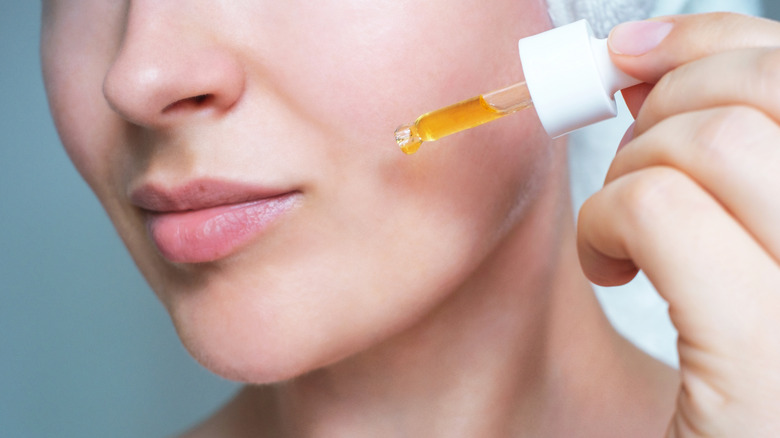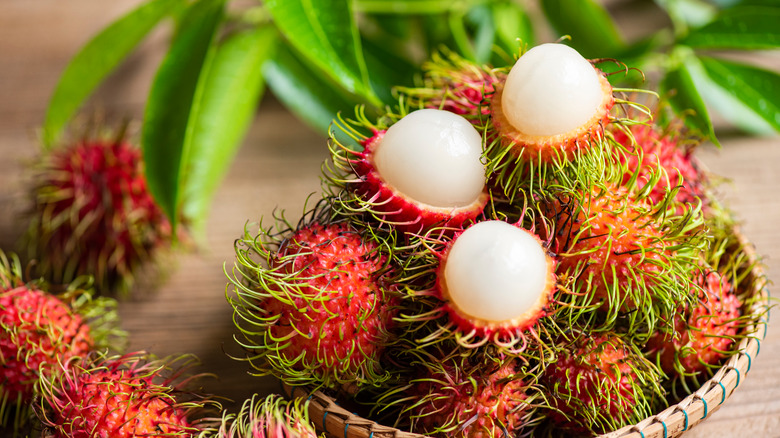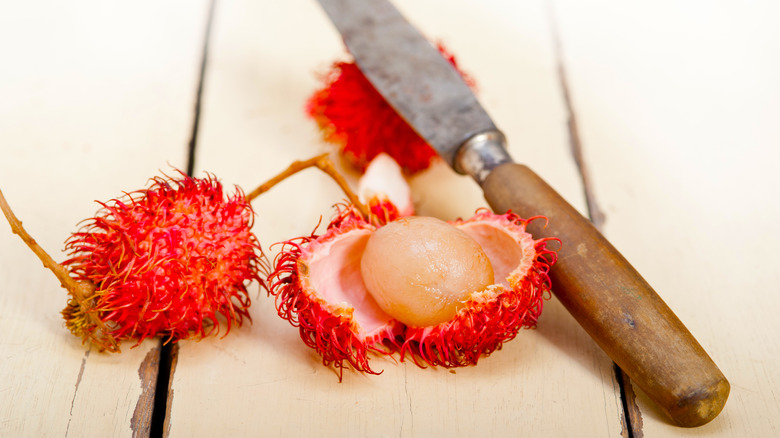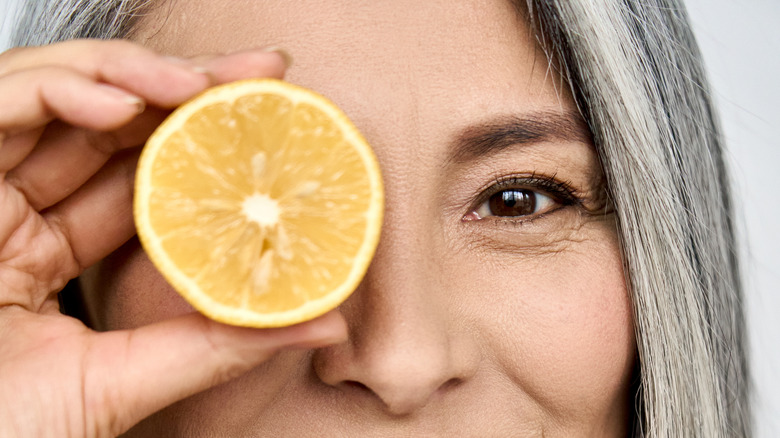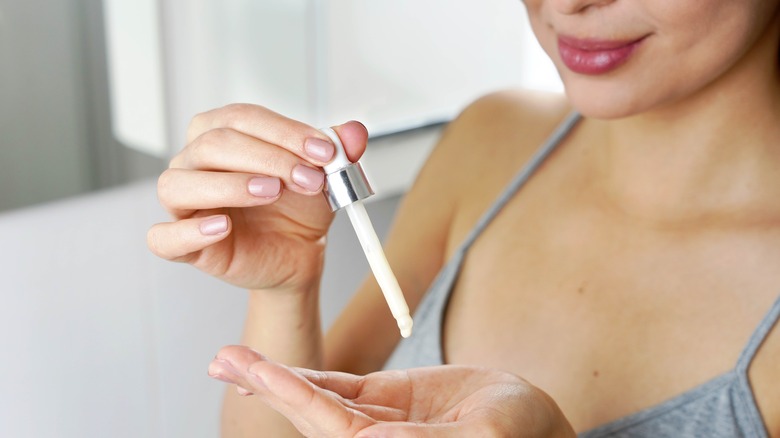Is Rambutan An Effective Retinol Alternative?
We may receive a commission on purchases made from links.
Is there anything as enjoyable as finding a skin care product that offers a wide array of benefits, and yields results? Whether you're a retinol groupie already or are just jumping on the bandwagon, there is no question about the perks of using it on your skin. From anti-aging properties to its ability to exfoliate and unclog pores, retinol is a wonder-product on the market. The Cleveland Clinic notes that the creams, serums, and lotions also prompt your skin to produce collagen, which is what gives your face a youthful, plump appearance.
By increasing the skin's production of cells, retinol is one of the most helpful for anyone battling wrinkles, fine lines, and signs of aging. However, as with every list of pros, there must be some cons. While retinol is incredibly potent, it can also be harsh on sensitive skin. Some people report seeing irritation, redness, and dryness, all of which can be off-putting to users. For those who feel retinol is too intense, there is hope in the form of another product: rambutan. Found in Southeast Asia, this fruit is comparable to a lychee, and offers a number of skincare benefits. But is it as good as the medicine cabinet staple everyone swears by? You might be pleasantly surprised by the findings.
What is rambutan?
Rambutan is a fruit that grows in Southeast Asia, predominately in the Philippines, Thailand, Indonesia, and Malaysia. The notable size and texture, which is similar to a sea urchin, earned this fruit its name — the Malay word for hair. Covered in red and green bristles, it looks more alien than something found here on Earth. Despite the strange appearance, rambutan is related to lychee, and everything from the build to the taste is said to be similar. Like its cousin, this fruit also offers a variety of benefits to humans, which Healthline says include aiding in digestion and protecting against certain infections.
Not only does it offer copious amounts of vitamin C and copper, but rambutan is also a great source of antioxidants. It is mainly the inner fruit that provides humans with the best internal health sources: The skin and seed aren't recommended to eat. However, these parts don't go to waste, and the outer layer is where scientists found a majority of the properties that can help your complexion. Waste not, want not — is there anything better than nature's treats?
What does rambutan do for your skin?
In scientific studies on the outer skin of a rambutan fruit, it was found to contain polyphenolic compounds. According to Aging (Second Edition), these are essentially antioxidant compounds, and contribute to reducing inflammation and aiding in anti-aging processes. The phenolic extract found within the peel can be used to guard your skin against free radicals, which cause oxidative stress that's detrimental to your complexion and skin.
Because phenolic compounds can permeate the topmost layer of your skin, they are able to be absorbed and provide your largest organ with anti-aging properties. Since these are found within rambutan peels, it's no wonder why skin care companies began using rambutan in their products. The benefits can't be denied, and you can find this ingredient in everything from creams and lotions to serums and peels. The biggest appeal might be that it gives consumers an alternative to standard retinols, and for good reason.
Rambutan versus retinol
Retinol can have its share of downsides, and some people choose to avoid it rather than risk side effects like dryness, irritation, and redness. Sure, the anti-aging properties are fantastic, but for those who have had bad reactions to this ingredient, it might not be worth it. So what to do if you want a serum or cream to help with cellular boosts and collagen production? Enter: rambutan. Thanks to elements like manganese and vitamin C, which are both found in the peel, this option not only helps create a youthful appearance, but it hydrates, too.
This all-in-one product protects your skin from UV radiation and oxidative stress, all while filling cells with good nutrients. Unlike retinol, which can be harsh and drying on certain skin types, rambutan doesn't diminish the natural moisture found in your epidermis, which AEdit notes is a massive bonus. Switching to mixtures that include or are made predominately from this fruit's peel could still give you the perks of retinol, without the drawbacks. Say goodbye to worry over redness and discomfort, because nature is usually one step ahead of science. It just takes a little research to find out how to harness these amazing ingredients, then turn them into your skin's new best friend.
How to use rambutan in your routine
There are a few different ways to use rambutan, though you should always start with a patch test to ensure your skin doesn't have a reaction to the ingredient. Once you've ensured it's safe to use for your complexion, try introducing a serum or cream a few nights a week into your routine. Even gentle antioxidants take time to work, but you don't want to oversaturate the skin, so take breaks at first between applications.
Brands like Alypn offer a wild nettle and niacinamide serum, which adds vitamin B and an extra dose of vitamin C to the rambutan found in the product, supercharging the active ingredients so your face will absorb all the goods whenever you use it. Sun Bum also offers a hydrating under eye cream made with rambutan, which is meant to brighten dark circles and help create a smooth overall texture around this delicate area. Regardless of how you use it, the fact that there is a plant-based option — which can be sustainably attained no less (as noted by Coveteur) — should give you enough reason to swap your retinol for the new R of skin care: rambutan.
